Related Topics
Philadelphia Economics
economics
Architecture in Philadelphia
Originating in a limitless forest, wooden structures became a "Red City" of brick after a few fires. Then a succession of gifted architects shaped the city as Greek Revival, then French. Modern architecture now responds as much to population sociology as artistic genius. Take a look at the current "green building" movement.
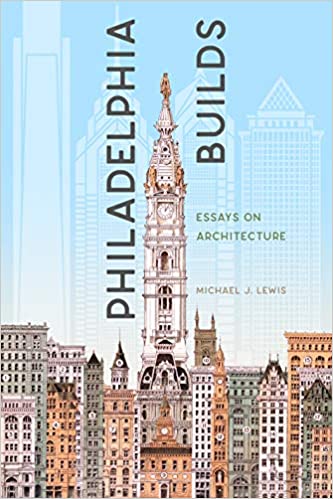
Historical Motor Excursion North of Philadelphia
The narrow waist of New Jersey was the upper border of William Penn's vast land holdings, and the outer edge of Quaker influence. In 1776-77, Lord Howe made this strip the main highway of his attempt to subjugate the Colonies.
New Jersey (State of)
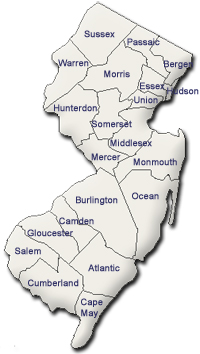 The Garden State really has two different states of mind. The motto is Liberty and Prosperity.
The Garden State really has two different states of mind. The motto is Liberty and Prosperity.
Roebling
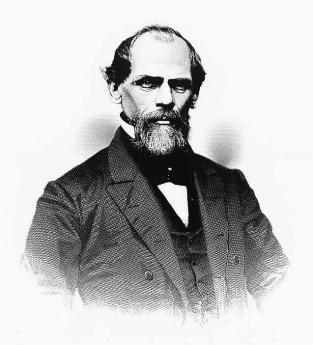
|
| John Roebling |
The common image of John A. Roebling comes across a little hazy about details, but seems to consist of going down with the Titanic at the age of 31, with being born in Prussia in 1837, with getting the "bends" while building the Brooklyn Bridge, and first sighting General Robert E. Lee's invading army from a balloon, then dragging a cannon up Little Round Top. The obvious inconsistencies in this image do not prove they are fictitious, they prove that Roebling was several people. Mostly this composite centers on Johann Augustus Roebling and his three sons, but spreads out to a large and highly talented family. Roebling achievements are not those of a bee, but of a beehive.
Johann was a younger child in a large Prussian family living a hundred miles south of Berlin. The region had been ruled under Napoleon for seven years, creating much of the centralized governance we now call "Prussian". Following centralized orders, its school had been designated to be an expert in science and engineering. Johann was particularly good at math and was singled out for intensive training in math and science, later sent to Berlin for advanced training in engineering. While there, he fell under the influence of the philosopher Hegel, who proclaimed that anyone could be anything he wanted to be, but opportunities were particularly good in America. Since Berlin went on to become the world center of electrical engineering, the world would probably have heard more of Johann Augustus Roebling even if he had remained at home; but he was going to do big things in the steel industry, so off he went to Pittsburgh. Things went rather well for him there, especially after he substituted wire rope for hemp rope in pulling canal boats over the Allegheny mountains. From that point on, John A. Roebling concentrated on perfecting and manufacturing wire cable, on which he held several key patents, and moved his business to the head of the Delaware Bay at Trenton, strategic in sales location between New York and Philadelphia.
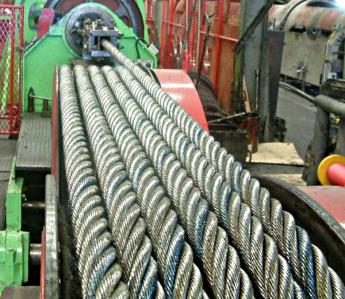
|
| Wire Rope Factory |
Although his company would eventually build an open hearth steel mill, the Roebling enterprise always retained a central focus on steel cables made of steel wires bound together for flexibility and strength. The plant next door in Trenton, the Cooper, Hewitt Co., created the steel I-beam and thus was central in the construction of skyscrapers. Roebling supplied steel cable for elevators, without which skyscrapers would have been limited to six or eight stories. The wires within the cables start from what we can now visualize as the child's toy Slinkies (also a Roebling product, by the way). The trick to making such coils into cables was to find a way to straighten them out, which Roebling devised and patented, using a wheel arrangement to twist the wire as it unwound. Later, the wires were galvanized and compressed together. If the cables were used to carry electricity, it was necessary to cover the cable with rubber insulation as part of the manufacturing process. Eventually, over fifty different processes needed to be perfected and employed to create large quantities of non-brittle uniform cable product at low prices. Apparently, the central problem in manufacture was to smooth off burrs in the wire and meanwhile keep the assembly scrupulously clean. Roebling learned how to overcome all of the many problems in this deceptively simple-looking process, which eventually meant that the main problems remaining were in designing factories rather than designing cables. During the taming of the west, he produced barbed wire; during the rise of mass agriculture, he devised ways to use wire binders for sheaves of wheat. During the rise of electricity, he provided insulated wire and cable, first for the telegraph and then for the telephone. He even recognized the best business model; make huge profits during the first few years of a new product, then cut prices. By far the most famous product of the Roebling company was the suspension cable in suspension bridges.
Indeed, many people associate the Roebling name with bridge building, even though wire cable was and continued to be the central activity of the company. It was characteristic of the Roebling energy and engineering skill that he saw that if he wanted to sell cable, he had to show others how to use it, and he essentially took over the design and construction oversight of the twelve largest suspension bridges in the country. Unfortunately, his foot was crushed in a construction accident and when he died, the building of the Brooklyn Bridge had to be turned over to his son Washington Roebling. Washington, in turn, became badly crippled by caisson disease, the "bends", and hands-on oversight was conducted in large part by his wife, following meticulous instructions by her partially blinded husband.

|
| Brooklyn Bridge |
The work of building and designing factories for the company fell to Washington's brother Charles, and since the company was constantly changing focus in order to exploit new product lines, it was a prodigious task, always under time pressure. What's more, the main factories burned to the ground at least six different times, probably from arson in at least several cases. The Roeblings all worked like dogs for endless hours, well into old age. There was comparatively little ostentatious display of wealth, and when US Steel offered to buy them out, they declined an offer equivalent to one-fifth of the value of US Steel itself. That was during an economic downturn; Roebling was probably worth half of the value of US Steel. Andrew Carnegie might sell out, but not the Roeblings.
George Washington once reversed the Revolutionary War just up the street from the Roebling plant, and John Roebling's son was named after him. Roebling was a patriot and an active Republican. But there was enough Prussian in him to prefer German workmen and to hate unions. When the company grew large, he was forced to hire immigrants from what he called the Hapsburg Empire, although he never completely trusted them. Judging from his writing, he regarded unions as merely trying to take away control of the company without investing in it, certainly without earning it. Surviving numerous fires, recessions, and wartime demands for expansion without profit, it was plainly obvious that when times were tough and money had to be raised, there was no one except the owner to produce it. It is not difficult to imagine the hatred in the minds of union leaders, confronting a family that regarded lowered wages during the depression as normal and necessary. In the Roebling view, standing up to worker protests in such circumstances was simply a test of character, something an owner simply had to find the courage to do.
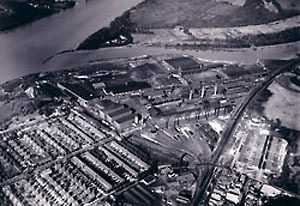
|
| Roebling Village 1930 |
When it became necessary to build a huge new plant at some distance downriver, the Roeblings had to contend with a shortage of labor in a region without houses. So they built a company town which they declined to name Roebling but the railroad named the stop Roebling anyway. Using engineering skill that had made Roebling the world leader, the homes were inexpensive but elegant for the time and even today. The company had to build stores, streets, schools, and everything else a town needed. The new headaches of this project took time and attention away from the central business of making steel cables, and Washington Roebling once wrote it was enough to drive you crazy.
So, guess what, the unions felt they had to take the lead in complaining and forcing the Roeblings to make changes. Guess what happened next; the Roeblings just sold it and walked away.
REFERENCES
| The Company Town: The Industrial Edens and Satanic Mills That Shaped the American Economy, Hardy Green ASIN: B003XKN7MW | Amazon |
Originally published: Sunday, June 01, 2008; most-recently modified: Wednesday, June 05, 2019
| Posted by: jbrando | May 22, 2012 2:48 PM |